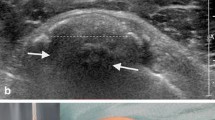Summary
We report a clinicopathological study of 90 patients who had calcifying tendinitis, and propose a rationale for its treatment based upon pathogenetic mechanisms. Pain, the cardinal symptom of calcifying tendinitis, is probably subclinical before and during calcification, when tissue hypoxia is primarily responsible for the structural alterations. The pain becomes extremely severe during the resorptive phase, when hyperaemia prevails. Corticosteroid injections at this time will lessen pain, but would impede the process of resorption because steroids inhibit macrophage function. Therefore, as soon as the pain subsides, pendulum movements of the arm with rest in abduction should be promoted to maintain vascular perfusion and calcium resorption. In case of recurrence of the acute pain, surgical removal of the calcium deposits is a better alternative than repeated corticosteroid injections.
Résumé
Les auteurs présentent une étude clinique et anatomo-pathologique de 90 malades porteurs d'une tendinite calcifiante et proposent des règles thérapeutiques basées sur la pathogénie de cette affection. La douleur, principal symptôme de la tendinite calcifiante, est probablement infra-clinique avant et pendant la période de calcification, quand l'hypoxie tissulaire détermine les lésions structurales. La douleur devient extrêmement vive à la phase de résorption quand prédomine l'hyperhémie.
A ce stade, les injections de corticoïdes peuvent diminuer les douleurs, mais elles sont susceptibles d'entraver le processus de résorption car elles inhibent la fonction des macrophages. Donc, tant que la douleur persiste, les mouvements pendulaires du membre supérieur et le repos, bras en abduction, doivent être préconisés afin d'entretenir la circulation et la résorption calcique. En cas de récidive des douleurs aiguës, l'ablation chirurgicale des calcifications est préférable aux injections itératives de corticoïdes.
Similar content being viewed by others
References
Basmajian, J. V.: The surgical anatomy and function of the armtrunk mechanism. Surg. Clin. North. Am. 43, 1471–1482 (1963)
Booth, R. E. Jr., Marvel, J. P. Jr.: Differential diagnosis of shoulder pain. Orthop. Clin. North. Am. 6, 353–379 (1975)
Codman, E. A.: The shoulder, pp. 75. Boston: Thomas Todd 1934
De Palma, A. F.: Surgical anatomy of the rotator cuff and the natural history of degenerative periarthritis. Surg. Clin. North. Am. 43, 1507–1520 (1963)
Dluhy, R. G., Lauler, D. P., Thorn, G. W.: Pharmacology and chemistry of adrenal glucocorticoids. Med. Clin. North. Am. 57, 1155–1165 (1973)
Glatthaar, E.: Zur Pathologie der Periarthritis humeroscapularis. Deutsche Zeitschrift für Chirurgie 251, 414–433 (1938 – 1939)
Karnovsky, M. J.: A formaldehyde-glutaraldehyde fixative of high osmolality for use in electron microscopy. J. Cell Biol. 27, 137A (1965)
Moseley, H. F.: The vascular supply of the rotator cuff. Surg. Clin. North. Am. 43, 1521–1522 (1963)
Olsson, O.: Degenerative changes of the shoulder and their connection with shoulder pain. Acta Chir. Scand. [Suppl.] 181, 1–130 (1953)
Pinals, R. S., Short, C. L.: Calcific periarthritis involving multiple sites. Arthritism Rheum. 9, 566–574 (1966)
Rathbun, J. B., MacNab, I.: The microvascular pattern of the rotator cuff. J. Bone Joint. Surg. 52-B, 540–553 (1970)
Rothman, R., Parke, W.: The vascular anatomy of the rotator cuff. Clin. Orthop. 41, 176–186 (1965)
Sarkar, K., Uhthoff, H. K.: The ultrastructural localization of calcium in calcifying tendinitis. Arch. Pathol. 102, 266–269 (1978)
Schaer, H.: Die Periarthritis humeroscapularis. Ergeb. Chir. Orthop. 29, 211–309 (1936)
Steinbrocker, O.: The painful shoulder. In: Arthritis and allied conditions, J. E. Hollander, ed., pp. 1468. Philadelphia: Lea and Febiger 1972
Uhthoff, H.: Calcifying tendinitis, an active, cell-mediated calcification. Virchows Arch. [Pathol. Anat.] 366, 51–58 (1975)
Uhthoff, H. K., Sarkar, K., Maynard, J. A.: Calcifying tendinitis. A new concept of its pathogenesis. Clin. Orthop. 118, 164–168 (1976)
Author information
Authors and Affiliations
Rights and permissions
About this article
Cite this article
Uhthoff, H.K., Sarkar, K. Calcifying tendinitis. International Orthopaedics 2, 187–193 (1978). https://doi.org/10.1007/BF00266076
Issue Date:
DOI: https://doi.org/10.1007/BF00266076




